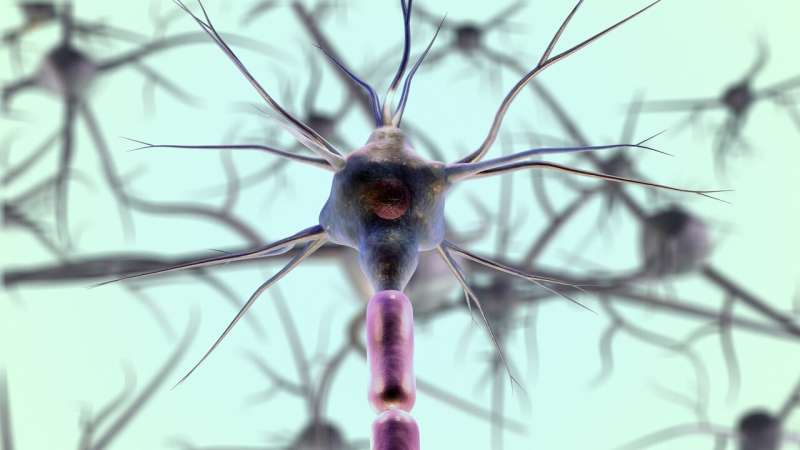This article has been reviewed according to Science X's editorial process and policies. Editors have highlighted the following attributes while ensuring the content's credibility:
fact-checked
peer-reviewed publication
trusted source
proofread
Nerve decompression shows promise for diabetic neuropathy patients

Surgical nerve decompression, used to treat conditions such as carpal tunnel syndrome and sciatica, could play a role in relieving the pain of diabetic neuropathy patients, researchers at UT Southwestern Medical Center found.
The five-year study, published in Annals of Surgery, was the first randomized control trial to assess the effectiveness of lower extremity nerve decompression surgery on patients with diabetic peripheral neuropathy.
Approximately 20 million Americans suffer from diabetic neuropathy, a progressive condition that damages the nerves, primarily in the legs and feet. The primary treatment today is the use of temporary pain-relieving medications, but many patients find them ineffective after prolonged use.
"Diabetic neuropathy can be debilitating, leading to a lack of mobility and a severe reduction in quality of life," said study leader Shai Rozen, M.D., Professor and Vice Chair of Plastic Surgery. "It's believed that roughly one-third of those with neuropathy pain have nerve compression—where there is direct and chronic pressure on a peripheral nerve—due to physiological changes brought on by diabetes. Our research suggests that nerve decompression surgery to release compressed nerves from surrounding tissue could offer lasting relief for those individuals."
In diabetic neuropathy, nerves can swell and eventually be compressed by surrounding semirigid tissue, causing pain, muscle weakness, or both. In the surgery, the semirigid tissue is removed from the swollen nerve, allowing for improved blood flow to relieve symptoms.
The study followed 78 patients at UT Southwestern and Parkland Health who were randomly placed into two groups—one receiving surgery and one serving as an observation group who remained on medication only. Those selected for surgery also had one leg randomly chosen for "sham surgery"—when the surgeon makes incisions to mimic the procedure but without principal therapeutic actions (i.e., nerve release)—while the other leg underwent nerve decompression.
Patients agreed to being blinded about which leg underwent sham surgery and which had decompression surgery. Additionally, the evaluators were blinded regarding which group the patients were in. "This masking of patients and evaluators further increases the reliability of the results," Dr. Rozen said.
During follow-up visits, patients completed standard pain and lifestyle questionnaires. At the 12-month visit, the patients who underwent surgical intervention reported significantly less pain in both legs, while the observation group's pain rankings were unchanged.
At 56 months, under the same patient- and evaluator-blinded conditions, the surgical group reported even greater pain reduction, while the observation group had worse pain. Unlike the 12-month follow-up, however, surgical patients reported far more improvement in their decompressed legs than in their sham surgery legs.
"The one-year reports of pain improvement in both legs could mean that there is a placebo effect taking place, but the five-year results suggest that the procedure actually does have a positive long-term impact on pain," Dr. Rozen said. "There is still much debate in the medical community about the value of decompression surgery in treating diabetic neuropathy, and while this study doesn't settle the issue, it should help expand the discourse among stakeholders and hopefully lead to even more research. The goal is to better understand the efficacy of nerve decompression surgery on diabetic neuropathy and improve our ability to identify patients who are likely to respond to surgical intervention."
Other UTSW researchers who contributed to the study are Steven Vernino, M.D., Ph.D., Professor of Neurology; Philip Raskin, M.D., Professor of Internal Medicine in the Division of Endocrinology; Linda Hynan, Ph.D., Adjunct Professor in the Peter O'Donnell Jr. School of Public Health and of Psychiatry; April Gorman, Ph.D., Biostatistician, O'Donnell School of Public Health; and Rita Fulmer, M.S.N., APRN, FNP-C, Physical Medicine & Rehabilitation.
More information: Shai M. Rozen et al, Effect of Lower Extremity Nerve Decompression in Patients with Painful Diabetic Peripheral Neuropathy, Annals of Surgery (2024). DOI: 10.1097/SLA.0000000000006228




















